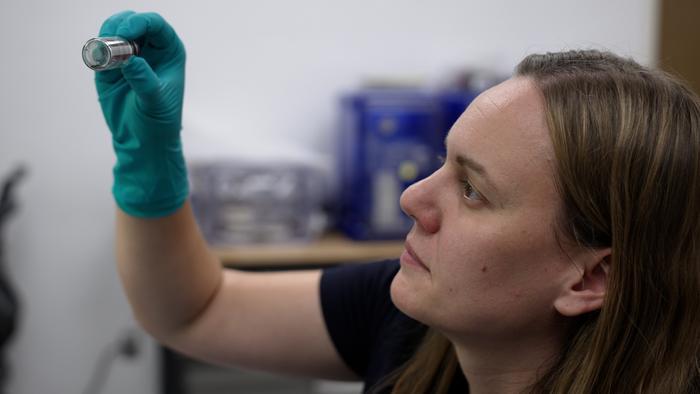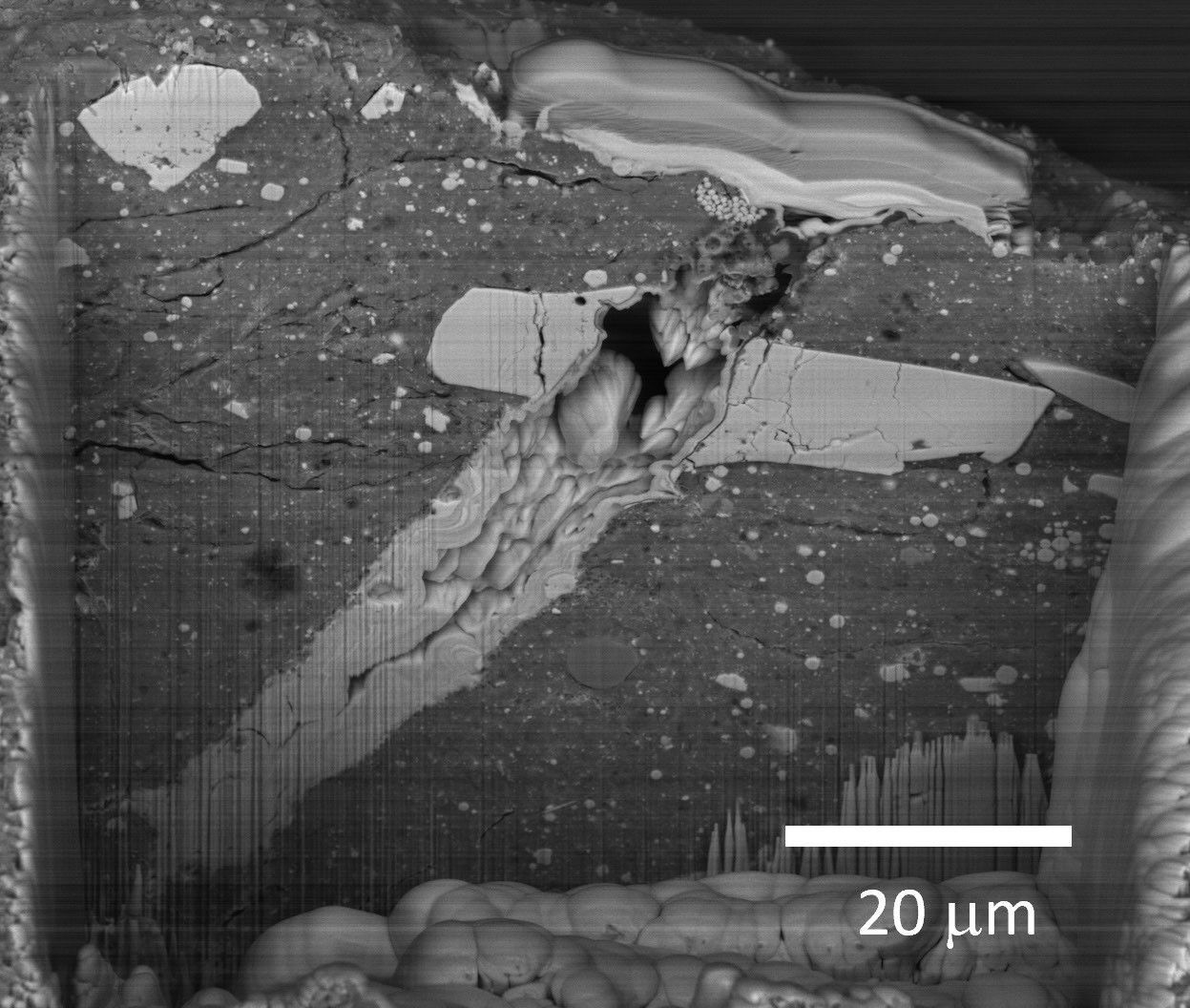23.08.2025
Three publications by members of the UA-led OSIRIS-REx sample analysis team reveal the asteroid's composition and history in unprecedented detail

Jessica Barnes examines a vial containing sample particles at the Kuiper-Arizona Laboratory for Astromaterials Analysis, located at the University of Arizona.
Asteroid Bennu — the target of NASA's OSIRIS-REx sample return mission, led by the University of Arizona — is a mixture of materials from throughout, and even beyond, our solar system. Over the past few billion years, its unique and varied contents have been transformed by interactions with water and the harsh space environment.
These details come from a trio of newly published papers based on analysis of Bennu samples delivered to Earth by OSIRIS-REx in 2023. The OSIRIS-REx sample analysis campaign is coordinated by the U of A's Lunar and Planetary Laboratory (LPL) and involves scientists from around the world. LPL researchers contributed to all three studies and led two of them.
"This is work you just can’t do with telescopes," said Jessica Barnes, associate professor at the U of A's Lunar and Planetary Laboratory and co-lead author on one of the publications. "It's super exciting that we're finally able to say these things about an asteroid that we've been dreaming of going to for so long and eventually brought back samples from."
Bennu is made of fragments from a larger "parent" asteroid that broke up after it collided with another asteroid, likely in the asteroid belt between the orbits of Mars and Jupiter. The parent asteroid consisted of material with diverse origins — near the sun, far from the sun, and from other stars — that coalesced more than 4 billion years ago as our solar system was forming. These findings are the subject of the first paper, published in Nature Astronomy and jointly led by Barnes and Ann Nguyen with the Astromaterials Research and Exploration Science Division at NASA’s Johnson Space Center in Houston.
"Bennu's parent asteroid may have formed in the outer parts of the solar system, possibly beyond the giant planets, Jupiter and Saturn," Barnes said. "We think this parent body was struck by an incoming asteroid and smashed apart. Then the fragments re-assembled and this might have repeated several times."
By looking at the samples returned by the OSIRIS-REx spacecraft, Barnes and her colleagues were able to get the most comprehensive snapshot of its history to date. Among the findings was an abundance of stardust, material that existed before our solar system formed, Barnes said. The discovery of these most ancient materials was made possible, in part, by the NanoSIMS instrument at the U of A's Kuiper-Arizona Laboratory for Astromaterials Analysis, which can reveal a sample's isotopes — variants of chemical elements — at nanometer scales. The tiny grains of stardust are identifiable by their unusual isotopic makeup compared to materials formed in the solar system.
"Those are pieces of stardust from other stars that are long dead, and these pieces were incorporated into the cloud of gas and dust from which our solar system formed," Barnes said. "In addition, we found organic material that's highly anomalous in their isotopes and that was probably formed in interstellar space, and we have solids that formed closer to the sun, and for the first time, we show that all these materials are present in Bennu."
The chemical and isotopic similarities between samples from Bennu and a similar asteroid, Ryugu, which was sampled by the Japanese Hayabusa 2 mission in 2019, and the most chemically primitive meteorites found on Earth suggest their parent asteroids may have formed in a shared region of the early solar system. Yet the differences researchers are observing in the Bennu samples may indicate that the starting materials in this region changed over time or were not as well-mixed as some scientists have thought.
The analyses show that some of the materials in the parent asteroid survived various chemical processes involving heat and water and even the energetic collision that resulted in the formation of Bennu. Nevertheless, most of the materials were transformed by hydrothermal processes, as reported in the second paper, published in Nature Geoscience. In fact, that study found, minerals in the parent asteroid likely formed, dissolved and reformed over time due to interactions with water.
"We think that Bennu’s parent asteroid accreted a lot of icy material from the outer solar system, which melted over time," said Tom Zega, director of the Kuiper-Arizona Laboratory who co-led the study with Tim McCoy, curator of meteorites at the Smithsonian.
The team found evidence that silicate minerals would have reacted with the resultant liquid water at relatively low temperatures of about 25 degrees Celsius, or room temperature. That heat could have either lingered from the accretion process itself, when Bennu's parent asteroid first formed, or was generated by impacts later in its history, possibly in combination with the decay of radioactive elements deep inside it. The trapped heat could have melted the ice inside the asteroid, according to Zega.
"Now you have a liquid in contact with a solid and heat — everything you need to start doing chemistry," he said. "The water reacted with the minerals and formed what we see today: samples in which 80% of minerals contain water in their interior, created billions of years ago when the solar system was still forming."
The transformation of Bennu's materials did not end there. The third paper, also published in Nature Geoscience, reports microscopic craters and tiny splashes of once-molten rock on the surfaces of Bennu particles — signs that the asteroid has been peppered by micrometeorite impacts. These impacts, together with the effects of solar wind, are known as "space weathering" and occur because Bennu does not have an atmosphere to protect it. This weathering is happening a lot faster than conventional wisdom would have it, according to the study, which was led by Lindsay Keller at NASA Johnson and Michelle Thompson at Purdue University.
As the leftover materials from planetary formation 4.5 billion years ago, asteroids provide a record of the solar system’s history. But many of these remnants may be different from what meteorites recovered on Earth would suggest, Zega said, because different types of meteors (fragments of asteroids) may burn up in the atmosphere and never make it to the ground.
"And those that do make it to the ground can react with Earth’s atmosphere, particularly if the meteorite is not recovered quickly after it falls," he added, "which is why sample return missions such as OSIRIS-REx are critical."
Quelle: AAAS
+++
NASA’s Bennu Samples Reveal Complex Origins, Dramatic Transformation

Asteroid Bennu, sampled by NASA’s OSIRIS-REx mission in 2020, is a mixture of dust that formed in our solar system, organic matter from interstellar space, and pre-solar system stardust. Its unique and varied contents were dramatically transformed over time by interactions with water and exposure to the harsh space environment.
These insights come from a trio of newly published papers based on the analysis of Bennu samples by scientists at NASA and other institutions.
Bennu is made of fragments from a larger parent asteroid destroyed by a collision in the asteroid belt, between the orbits of Mars and Jupiter. One of the papers, co-led by Jessica Barnes at the University of Arizona, Tucson, and Ann Nguyen of NASA’s Johnson Space Center in Houston and published in the journal Nature Astronomy, suggests that Bennu’s ancestor was made up of material that had diverse origins—near the Sun, far from the Sun, and even beyond our solar system.
The analyses show that some of the materials in the parent asteroid, despite very low odds, escaped various chemical processes driven by heat and water and even survived the extremely energetic collision that broke it apart and formed Bennu.
“We traced the origins of these initial materials accumulated by Bennu’s ancestor,” said Nguyen. “We found stardust grains with compositions that predate the solar system, organic matter that likely formed in interstellar space, and high temperature minerals that formed closer to the Sun. All of these constituents were transported great distances to the region that Bennu’s parent asteroid formed.”
The chemical and atomic similarities of samples from Bennu, the asteroid Ryugu (sampled by JAXA’s (the Japan Aerospace Exploration Agency) Hayabusa2 mission) and the most chemically primitive meteorites collected on Earth suggest their parent asteroids may have formed in a similar, distant region of the early solar system. Yet the differences from Ryugu and meteorites that were seen in the Bennu samples may indicate that this region changed over time or did not mix as well as some scientists have thought.
We found stardust grains with compositions that predate the solar system, organic matter that likely formed in interstellar space, and high temperature minerals that formed closer to the Sun.
ANN NGUYEN
Planetary Scientist
Though some original constituents survived, most of Bennu’s materials were transformed by reactions with water, as reported in the paper co-led by Tom Zega of the University of Arizona and Tim McCoy of the Smithsonian’s National Museum of Natural History in Washington and published in Nature Geoscience. In fact, minerals in the parent asteroid likely formed, dissolved, and reformed over time.
“Bennu’s parent asteroid accumulated ice and dust. Eventually that ice melted, and the resulting liquid reacted with the dust to form what we see today, a sample that is 80% minerals that contain water,” said Zega. “We think the parent asteroid accumulated a lot of icy material from the outer solar system, and then all it needed was a little bit of heat to melt the ice and cause liquids to react with solids.”
Bennu’s transformation did not end there. The third paper, co-led by Lindsay Keller at NASA Johnson and Michelle Thompson of Purdue University, also published in Nature Geoscience, found microscopic craters and tiny splashes of once-molten rock – known as impact melts – on the sample surfaces, signs that the asteroid was bombarded by micrometeorites. These impacts, together with the effects of solar wind, are known as space weathering and occurred because Bennu has no atmosphere to protect it.
“The surface weathering at Bennu is happening a lot faster than conventional wisdom would have it, and the impact melt mechanism appears to dominate, contrary to what we originally thought,” said Keller. “Space weathering is an important process that affects all asteroids, and with returned samples, we can tease out the properties controlling it and use that data and extrapolate it to explain the surface and evolution of asteroid bodies that we haven’t visited.”

As the leftover materials from planetary formation 4.5 billion years ago, asteroids provide a record of the solar system’s history. But as Zega noted, we're seeing that some of these remnants differ from what has been found in meteorites on Earth, because certain types of asteroids burn up in the atmosphere and never make it to the ground. That, the researchers point out, is why collecting actual samples is so important.
“The samples are really crucial for this work,” Barnes said. “We could only get the answers we got because of the samples. It's super exciting that we're finally able to see these things about an asteroid that we've been dreaming of going to for so long.”
The next samples NASA expects to help unravel our solar system’s story will be Moon rocks returned by the Artemis III astronauts.
NASA’s Goddard Space Flight Center provided overall mission management, systems engineering, and the safety and mission assurance for OSIRIS-REx. Dante Lauretta of the University of Arizona, Tucson, is the principal investigator. The university leads the science team and the mission's science observation planning and data processing. Lockheed Martin Space in Littleton, Colorado, built the spacecraft and provided flight operations. Goddard and KinetX Aerospace were responsible for navigating the OSIRIS-REx spacecraft. Curation for OSIRIS-REx takes place at NASA’s Johnson Space Center in Houston. International partnerships on this mission include the OSIRIS-REx Laser Altimeter instrument from the Canadian Space Agency and asteroid sample science collaboration with JAXA’s Hayabusa2 mission. OSIRIS-REx is the third mission in NASA's New Frontiers Program, managed by NASA's Marshall Space Flight Center in Huntsville, Alabama, for the agency's Science Mission Directorate in Washington.
Melissa Gaskill
Johnson Space Center
Quelle: NASA
